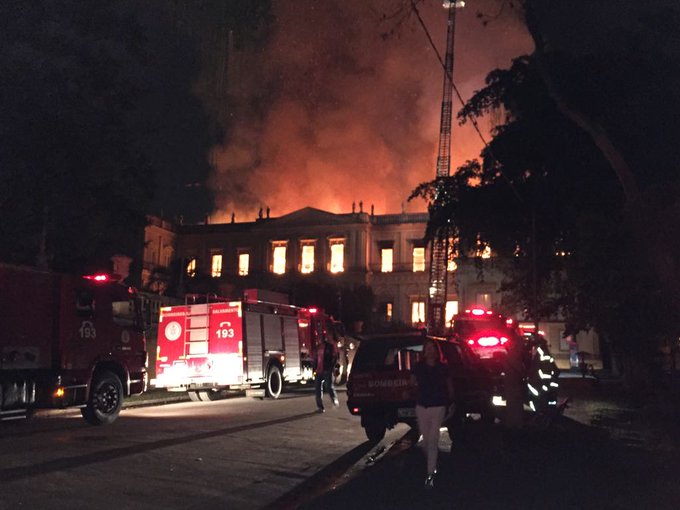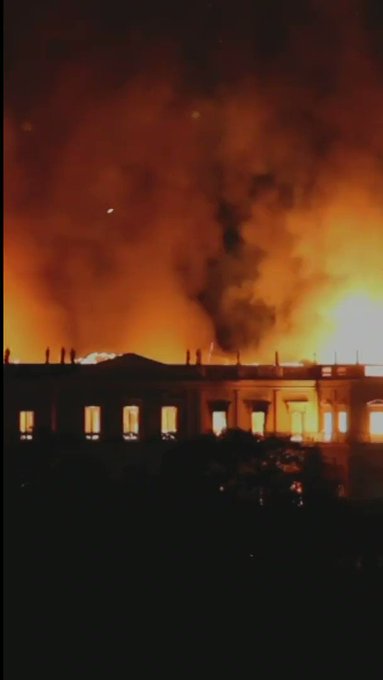🔺THE DEEP STATE JUDICIAL FAMILY OF BRAZIL CAMPAIGNS, CALLING THE PATRIOTIC ANTI-MAFIA OPPOSITION, "COMMUNISTS", IN THE MEDIA THEY THEMSELVES OWN, IN THEIR BID TO WIN UPCOMING ELECTIONS AS UNDERDOGS.
Stunning Footage Inside Brazil's Fire-Gutted National Museum
It contained centuries-old priceless artifacts charting the history of an entire country and people. The National Museum of Brazil was established in 1818 under King John VI of Portugal and contained over 20 million exhibits and artifacts, but was consumed completely by a devastating fire on Sunday night after it closed for the day.
Now Brazilians are raging at their government's failure to take simple preventative measures that could have saved the museum after its central building caught fire, quickly engulfing side buildings, which firefighters were helpless to do much about. There wasn't even so much as a working fire suppression system, considered standard for most any national antiquities museum across the globe, according to local reports.
Witnesses say that though security and other staff were evacuated in time, nothing of the museum's priceless collection could be saved.
"This is a tragic day for Brazil," Brazilian President Michel Temer said in a statement the following day. "Two hundred years of work and research and knowledge are lost."
And the director National History Museum told Globo TV that "this is a cultural tragedy."
Meanwhile Reuters reported that the institution had suffered from years of neglect under numerous governments: "We never got anything from the federal government… We recently finalized an agreement with (state-run development bank) BNDES for a massive investment, so that we could finally restore the palace and, ironically, we had planned on a new fire prevention system," said museum vice director Luiz Duarte.
Others also lashed out at the pattern of neglect which they say led to the fire. Luiz Fernando Dias Duarte, a deputy director, vexpressed “profound discouragement and immense anger” according to local reports, and accused Brazilian authorities of a “lack of attention”.
“We fought years ago, in different governments, to obtain resources to adequately preserve everything that was destroyed today,” Dias Duerte told journalists.
In recent years the museum had reportedly suffered from severe funding cuts. Many Brazilians took to social media in the immediate aftermath, calling out the hypocrisy of floating massive funds toward hosting the Rio 2016 Summer Olympics or building towering soccer stadiums, but all the while starving the national museum for funds.
The main building of the museum, now utterly destroyed after in took firefighters some five hours to snuff out the fire, was once the residence of the Portuguese royal family.
Per Axios, among the priceless items destroyed include the following:
- One of the Americas' oldest human fossils — the skull and bones of a 25-year-old "Luzia" who died around 11,500 years ago, according to National Geographic.
- It also held the largest meteorite ever found in Brazil, bones of Brazilian dinosaurs as well as Latin America's oldest collection of ancient Egyptian mummies and artifacts.
- The museum housed one of the best collections of indigenous literature, Guardian journalist Jonathan Watts wrote on Twitter. Urutau Guajajara, a leader and researcher of indigenous right, told Watts, “This is the greatest loss of indigenous writing in Latin America... Our memory has been erased."
- There were also pre-Colombian, Incan treasures, according to the museum's website, and extensive collections of ancient Greek and Roman artifacts.
- Some items were brought to Brazil by the country's founder and first ruler Dom Pedro I, according to the Guardian.
There's yet to be an official reason given for the cause of the fire, but multiple reports suggest the museum's structure and wiring had suffered from years of neglect and was in dire need of repairs.
"Very little will be left," preservation director Joao Carlos Nara told Agencia Brasil,according to CNN.
Judging from the new to emerge footage inside the museum showing the aftermath, it appears that all is indeed lost.













